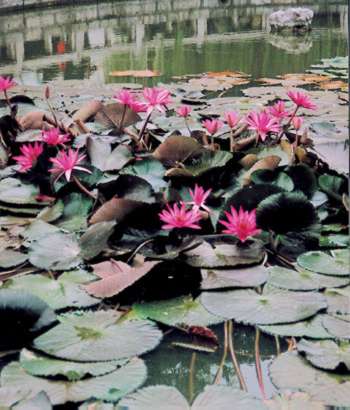Qigong (pronounced Chi-Gong) is the ancient art of longevity developed over 6000 years ago in China. Qi (Chi) is the energy of the body that travels through the network of meridians and connects with the energy of the universe. According to the ancient Daoists, the whole universe has some element of Qi. It can be translated as vital energy, breath or energy of life. Gong (Kung) is a term that describes the work that is required to achieve a skill; Gong can also be translated as training, mastery, or self-discipline. When we have a blockage of Qi or the pathway is disturbed this can cause sickness (both physical and emotional) and eventually shortness of life. Qigong is a conscious practice where each individual takes personal responsibility to balance and harmonize their vital energy – reducing stress, increasing health and vitality as well as developing spiritual perception and awareness. Qigong literally is working with the energy of life.
 Qigong is the art of life. When we see people practicing slow gentle movements in the early morning, in parks in China and most countries today we may think they are playing Tai Chi, but they are actually cultivating their life force energy (Qi). Qigong is a relatively a new term used since the 1950’s ans is used to describe all the Chinese energy healing techniques, so technically Tai Chi (Taijiquan) is one type of Qigong. The art of Qigong consists primarily of meditation, relaxation, physical movement, mind-body integration and breathing exercises. There are thousands of different styles and systems either done standing, moving, walking, sitting or laying down.
Qigong is the art of life. When we see people practicing slow gentle movements in the early morning, in parks in China and most countries today we may think they are playing Tai Chi, but they are actually cultivating their life force energy (Qi). Qigong is a relatively a new term used since the 1950’s ans is used to describe all the Chinese energy healing techniques, so technically Tai Chi (Taijiquan) is one type of Qigong. The art of Qigong consists primarily of meditation, relaxation, physical movement, mind-body integration and breathing exercises. There are thousands of different styles and systems either done standing, moving, walking, sitting or laying down.
In Traditional Chinese Medicine, good health is a result of a free-flowing, well-balanced energy system. Ailments both physical and emotional may occur when Qi flow is blocked or impeded, causing imbalance and dysfunction in the body’s energy system. With regular practise Qigong helps to cleanse the body of toxins, restore energy, reduce stress and anxiety, and help individuals maintain a healthy and active life
Three main categories of Qigong
- Martial/Sports Qigong
- Medical/Healing Qigong
- Spiritual/Meditation Qigong
There are basically two types of Qigong training, external and internal.
External Training also known as Wei Gong, (Yang) relates to the physical movement forms, the external movement stimulates and guides the flow of Qi.
Internal Training also known as Nei Gong, (Yin) relates to the movement and stillness forms where internal concentration or intention stimulates and guides the flow of Qi.
The three principles of Qigong
- Regulating the posture, learning to stand, sit or move with the body relaxed and correctly aligned.
- Regulating the breath, there are many different breathing patterns used.
- Regulating the Mind, entering a quiet state allowing intention to guide the Qi.
[text]When starting to cultivate Qi energy it is advised to start with movement, especially when we are younger. A good way is with Tai Chi (Taijiquan), a popular internal form of Martial Qigong, helping to teach discipline, and co-ordination of mind and body. This is very beneficial for the maintenance of the body. In the tradition of Qi cultivation the Martial (Warrior) can help stimulate our exploration of internal energy and lead us to the next stage, that of the scholar. Studying Traditional Chinese Medicine, the I Ching and other classical works can lead to the next level: that of the healer. Through Medical Qigong we are able to help others strengthen and maintain their health. Then the practice of meditation takes us to the final stage, Spiritual Qigong, uniting with the universe /Dao/God: whatever your belief. This is the ultimate aim. From the physical to the internal and onto the spiritual, by sharing and helping others are we able to grow and find more purpose for our life. When we practice Qigong and other energy and meditative arts we are not only benefiting ourselves but all living things, helping bring harmony to the universe.
 Of all the energy medical practices, Qigong has been subjected to the most extensive research. In China, Medical Qigong is now practiced in clinics and some hospitals that integrate Traditional Chinese Medicine (TCM) and conventional Western medicine. In Western hospitals Qigong is among several complementary practices used including therapeutic touch and mindful meditation. In the early 1980s Chinese scientists initiated research on the health and healing claims of Qigong. Of the hundreds of research studies that were performed, few were published because suitable journals were unavailable. However, about 1,400 reports were published as abstracts in the proceedings of conferences. English abstracts of these reports as well as those from scientific journals are collected in the Qigong and Energy Database that presently contains more than 5,000 abstracts of Qigong studies and is
Of all the energy medical practices, Qigong has been subjected to the most extensive research. In China, Medical Qigong is now practiced in clinics and some hospitals that integrate Traditional Chinese Medicine (TCM) and conventional Western medicine. In Western hospitals Qigong is among several complementary practices used including therapeutic touch and mindful meditation. In the early 1980s Chinese scientists initiated research on the health and healing claims of Qigong. Of the hundreds of research studies that were performed, few were published because suitable journals were unavailable. However, about 1,400 reports were published as abstracts in the proceedings of conferences. English abstracts of these reports as well as those from scientific journals are collected in the Qigong and Energy Database that presently contains more than 5,000 abstracts of Qigong studies and is
available from the Qigong Institute www.qigonginstitute.org
I remember quite clearly being in hospital and after three months finally starting to walk again. With the use of a walking frame I would very slowly and carefully walk around the ward. I was just so excited that I was making progress. One nurse would lead me to other patients who were feeling down and depressed, so I would tell them my story. I could see the change in their eyes and the healing taking place. Since that day I have been inspired to share all that I learn and know so I may be able to receive more.
